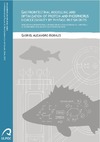Identificador persistente para citar o vincular este elemento:
https://accedacris.ulpgc.es/jspui/handle/10553/9767
| Título: | Gastrointestinal modelling and optimization of protein and phosphorus bioaccessibility by phytase in fish diets | Autores/as: | Morales, Gabriel Alejandro | Director/a : | Moyano López, Francisco Javier Izquierdo López, María Soledad |
Clasificación UNESCO: | 251092 Acuicultura marina | Palabras clave: | Digestión in vitro Alimentación animal |
Fecha de publicación: | 2012 | Resumen: | La investigación descrita en esta tesis trata sobre la optimización de un modelo gastrointestinal (GIM) diseñado para evaluar la biodisponibilidad de proteínas y el fósforo (P) dietario simulando las condiciones del ambiente digestivo del pez. Los resultados demostraron la importancia de incluir una fase ácida durante la simulación del proceso de digestión proetica y del P en el sistema digestivo de los peces. La inclusión de un módulo de diálisis para simular la fase intestinal de la digestión permitió la evaluación de la dinámica de liberación del P resultante de la hidrólisis enzimática. Se evaluó la relación entre los valores de biodisponibilidad in vitro del nitrógeno (N) y el P y los valores in vivo de su retención y descarga utilizando truchas arco iris alimentadas con dos dietas comerciales. El GIM ha demostrado ser una buena herramienta para discriminar la calidad de las proteínas y la biodisponibilidad del P entre las dos dietas comerciales utilizadas. Los resultados obtenidos en la presente tesis pueden ayudar a alcanzar una mejor comprensión de los mecanismos subyacentes entre las interacciones proteína-IP6 y la biodisponibilidad de proteínas y AA de los ingredientes vegetales utilizados en la fabricación de alimentos para peces. The research described in this thesis addresses the optimization of a gastrointestinal model (GIM) designed to closely simulate the conditions in the gut to evaluate dietary protein and phosphorus (P) bioavailability in live fish. The GIM was improved by simulating pH changes taking place in the gastric and intestinal digestion, by using the enzyme:substrate ratio estimated from data obtained from live fish. Results demonstrated the importance of including an acid phase to simulate protein and P digestion in the gut of stomached fish. The inclusion of a dialysis module to simulate the intestinal phase of the digestion allowed assessment of the P liberation dynamics resulting from enzymatic hydrolysis. This is not only interesting from a nutritional perspective, but also from an environmental perspective. Thus, the relationship between in vitro values of nitrogen (N) and P bioavailability and in vivo values of their retention and waste output in two commercial feeds was evaluated. The GIM proved to be a good tool to discriminate between two commercial fish diets in protein quality and P bioavailability. Another major objective of this thesis was to assess the effect phytic acid (myo–Inositol hexaphosphate, IP6) dephosphorylation by phytase on IP6–proteins interactions within the gastrointestinal tract of fish. Experiments indicated that under the acidic–pepsin environment of stomached fish, E. coli phytase is more active and stable than phytase from P. lycii. The use of E. coli phytase as an additive in soybean meal prevented the formation of binary protein– IP6 complexes and improved amino acid (AA) release under fish gastric conditions. No effect was, however, observed on protein solubilisation or AA liberation under intestinal conditions, suggesting that ternary protein–cation–IP6 complexes are not important in respect to the reduction of protein availability by IP6. In vitro experiments indicated that IP6 reduce the proteolytic activity of mammalian and fish pepsin. In agreement with this, in vivo measures of gastric protease activity was higher in fish fed plant–based diet with inclusion of phytase than those fed the control diet without phytase. Trypsin activity was affected by the presence of IP6 under in vitro conditions, but not under in vivo conditions. Chymotrypsin did not appear to be affected by IP6. Results indicated that phytase increases the solubility of the different protein fractions from plant origin differently, being more evident for leguminous seeds compared to cereals or canola. A significant positive correlation between SDS–PAGE protein solubility increment and the content of basic AA in proteins fractions of main ingredients was obtained, except for conglutin. This suggests that the proportion of basic AA in a polypeptide cannot fully explain the IP6–induced ! xii ! changes in protein solubility or hydrolysis. The dephosphorylation of native IP6 positively affected both the bioavailability of P and AA, but the effect depended on the type of plant ingredient. The results obtained in the present thesis may help to get a better understanding of the underlying mechanisms for the IP6–protein interaction and the availability of proteins and AA in plant ingredients used in fish feeds. |
Descripción: | Programa de doctorado: Acuicultura | Departamento: | IU de Sanidad Animal y Seguridad Alimentaria | Facultad: | Facultad de Ciencias del Mar | Instituto: | IU de Sanidad Animal y Seguridad Alimentaria | URI: | https://accedacris.ulpgc.es/handle/10553/9767 | Derechos: | by-nc-nd |
| Colección: | Tesis doctoral |
Visitas
206
actualizado el 23-nov-2024
Descargas
310
actualizado el 23-nov-2024
Google ScholarTM
Verifica
Comparte
Exporta metadatos
Los elementos en ULPGC accedaCRIS están protegidos por derechos de autor con todos los derechos reservados, a menos que se indique lo contrario.
